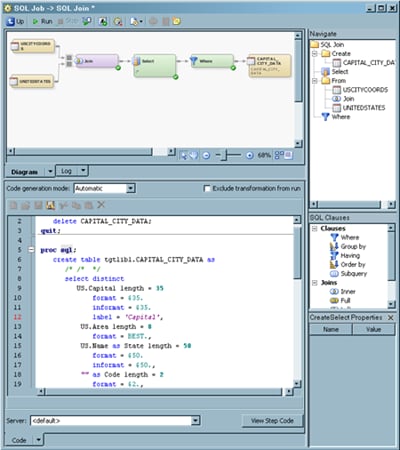Creating a Simple SQL Query
Solution
Use the SQL Join transformation
to create an SQL query that runs in the context of a SAS job. The
transformation features a graphical interface that enables you to
build the statements and clauses that constitute queries. This example
describes how to use the transformation to create a job that uses
an SQL query to select data from two SAS tables. The data is merged
into a target table.
Tasks
Create and Populate the Job
-
Because you want to have a permanent target table to contain the output for the transformation, right-click the temporary work table that is attached to the SQL Join transformation and click Replace in the pop-up menu. Then, use the Table Selector window to select the target table for the job. The target table must be registered in SAS Data Integration Studio. (For more information about temporary work tables, see Working with Default Temporary Output Tables.)Note: If you keep the worktable, you must add the Table Loader transformation to the job in order to connect the target table into the job flow. The Table Loader provides additional load options and combinations of load options, but it is not needed for many jobs. The extra processing that is required for the Table Loader can degrade performance when the job is run. In addition, you should not use a temporary output table and a Table Loader step if you use pass-through processing when your target table is a DBMS table and your DBMS engine supports the
Create as Selectsyntax.
Create the SQL Query
-
Click SQL Join in the Navigate pane. The right-hand side of the Designer window contains a Navigate pane, an SQL Clauses/Tables pane, and a properties pane. You might need to resize the horizontal borders of the panes to see all three of them. For more information, see Using the Designer Window.
-
Click Create in the Navigate pane to display an initial view of the query on the Diagram tab. Note that the sample query already contains an INNER join, a SELECT statement, and a WHERE clause. These elements are created when you drop source tables on the transformation template. The joins shown in the query process flow are not necessarily joined in the order in which the SQL optimizer actually joins the tables. However, they do reflect the SQL syntax.

